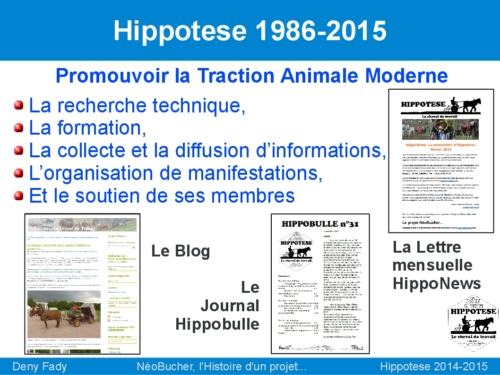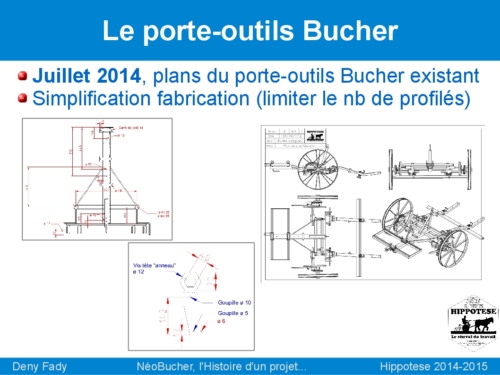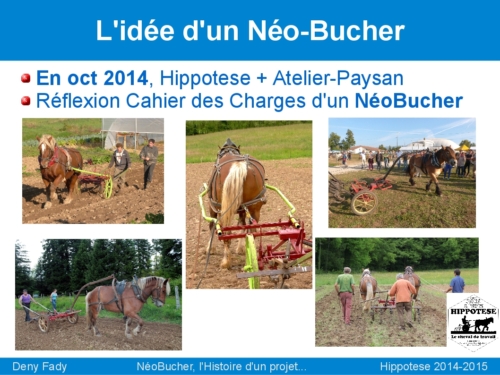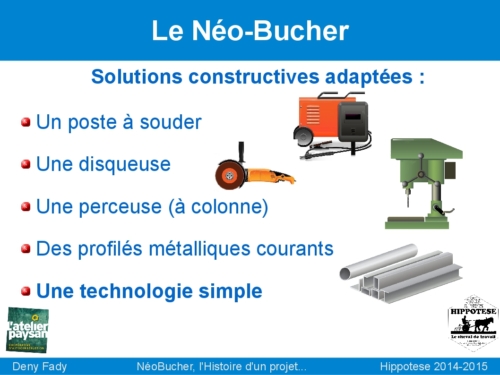Slideshow about the NeoBucher project history (English version, may 2015)
The NeoBucher project story

01 : The NeoBucher project : story of the rebirth of horse draught multi-tillage implement Bucher TM.
This project, still in progress today, is supported by Hippotese. Hippotese is a French none-profit organization which promotes draft equids power.

02 : Hippotese was founded in 1986 by the merger of two French personnalities and two French organisations who have been positively committed to the use of draught horses. One came from Jura, and the other from Alps country (Deny Fady chairman of CEP Savoie and Jean Louis Cannelle chairman of ARTAP Franche-Comté).
The name "HIPPOTESE" means Hippomobile and Technology Experimentations from SouthEast France.

03 : Since 1986, Hippotese conducts technical research (about collars, harnesses, horse-drawn vehicles and equipment for agricultural, forestry and urban uses...), offers professional training, collects and spreads historical and technical documentation (on its website, on its blogspot, in its Hippobulle-newspaper and its monthly HippoNews-newsletter), organizes promotional events about horse draft power and supports its members in their activities (loan of equipment, collective self-help projects, helping hands...).

04 : The Bucher (Bucher Guyer AG) horse draught multi-tillage implement had been available since the 30's. It had been manufactured until the 60's.
It is an implement for open-field vegetable crops and market gardening.
It has simple and easily constructible frame and lightweight design. It is equipped with a toolbar-lifting system.

05 : The Bucher possesses rare qualities, such as the possibility to till 2 rows at once (3 ranks available), and 2 path correcting systems so tillage can be very precise.
Besides, when changing from one kind of tillage to another, users change the whole tool-bar very easily, without taking of each tool, and so without changing set-space between tools.
It can be draft by a single horse, or a pair.

06 : Hippotese discovered the Bucher in the 90's, and published a first technical documentation in 1992 in our magazine Hippobulle n°15-16.
In 2006, on Hippotese's blog, we wondered about re-manufacturing this implement, with no answer to this question.

07 : Between 2007 and 2008, we imported dozens of second-hand Buchers from Switzerland, until we couldn’t get any more.
Again, we wondered about re-manufacturing, but without trying anything to that point yet.

08 : Then, since 2010, many people have been creating market gardening implements, but none was really based on the Bucher.
It seemed quite stupid to us to try and re-invent something that already existed, that had been improved during many years, which was at once very simple and very sophisticated, and which was quite simple to copy.
Moreover, none of these new multi-tillage implements met the three main functions of the Bucher : 1 horse, 2 rows and path correcting system..

09 : On July 2014, we decided to pay a craftsman to draw the (original) Bucher technical drawings (manufacturing diagrams), so we could share them with anybody who would like to built a new one, identical to the old one.
Secondly, from these first technical drawings, we tried and simplified the manufacturing pattern, using as few as possible different shaped metal bars and limiting the number of sections of metal profiles used.
Then, we thought about changing a few particular parts which used to be in cast iron, so they could be crafted only by welding from usual shaped metal bars.

10 : In October 2014, next step was to slightly improve the original model, to adapt this implement to our uses. And so, from simply copying the Bucher, now we were working on a Neo-Bucher project !
We gathered as many Bucher users as we could – about 20 people- to produced guidelines about what should be kept identical, and what should be changed.
That is when we took the society of Cooperative Interest "L'Atelier Paysan" as a partner on this project. L'Atelier Paysan has technical knowledge and experience on designing self-manufacturable market gardening implements.
Together we have sought simple, efficient and reliable solutions (original or not) to the building of the NeoBucher.

11 : We decided :
- to spread on free license “Creative common” what we would achieved,
- to allow market gardeners to self-manufacture their own implement, by offering formative sessions organised by L'Atelier Paysan,
- to allow professional craftsmen to manufacture parts or whole implements for people who would like to buy them ready to use.

12 : We decided to find building solutions adapted to the equipment of a farm basic mechanical workshop. Namely : a arc welding machine, a angle grinder, a bench drill and usual metal profiles.
We don't cross out the possibility to achieve a few complex parts (turning, laser cutting …) with external craftsmen.
This solution allows to built NeoBuchers worldwide using local technical means.

13 : From October 2014 to January 2015, Axel, an engineer student doing an internship at l'Atelier Paysan, accepted to work on technical solutions to our guidelines, on the 3D technical drawings for both versions of the Bucher, discussing his work with us at each step.
Many exchanges took place between members of the working group (Hippotese, l'Atelier Paysan and Bucher users). They brought simple technical solutions, some inspired by other efficient implements, some entirely new. Only the best ones were kept.

14 : In Feburary 2015, a first self-manufacturing workshop was organised with 13 people plus Axel and his boss Joseph.
In 3 days, (and more than 300 hours of work), 2 identical prototypes were produced, which proved the chosen technical solutions feasibility.

15 : In the process, Hippotese was asked to present, 15 days later, a Neo-Bucher prototype at the 2015's International Agriculture Show in Paris. We hasten to make one prototype presentable.

16 : Early March 2015, the prototype (number 002) had been presented twice at the "Innovative Horse-Drawn Equipment Demonstrations", in front of the French Minister for Agriculture.

17 : Mid-March 2015, Hippotese touched the bottom of its self-funding capacities.
So we launched a crow-funding project through the web site KissKissBankBank.com, hoping to collect enough money to equip the new tool-bars with tools from manufacturers, and to start the first real-conditions tests at spring.

18 : End of March 2015, we presented one this same 002 prototype and the "NeoBucher Project" at the FECTU Annual General Meeting (European Federation for Draught Animals) in Italy, to our European friends.

19: On April 2015, we organized a 2 days workshop to make changes and improvements on the 002 prototype, especially on the lifting system and the toolbar.
This workshop took place in a market gardening and aromatic and medicinal plants farm where the 002 prototype will stay to be tested for the whole season.

20 : On May 2015, intensive real-conditions tests started. And results are hopeful...

21 : Which is still to be done...
- We plan to test and develop the prototypes from May to September, 2015.
- Mid-September 2015, the NeoBucher will be presented at the Tech & Bio organic show in Valence (South-East of France).
- From October 2015 to the end of 2015, we will prepare the final Neo-Bucher technical drawings and manufacturing tutorial.
- Early 2016: We hope to spread drawings and organize the first training for self-building this horse-draught multi-tillage implement.
Follow the project on the Hippotese website : http://hippotese.fr
Deny Fady, Chairman of Hippotese, may 2015
(Special thanks to Nina et Jérôme for translate)
The crow-funding effort for this project will end on May 26, 7h32 pm, we hope to reach our goal of 7000 euros, which will allow Hippotese to keep working on this project.
NB : crow-funding adress : http://www.kisskissbankbank.com/neo-bucher-traction-animale-et-innovation
Download Slideshow about the NeoBucher project story (English version, may 2015, PDF) here.



















10 Derniers commentaires